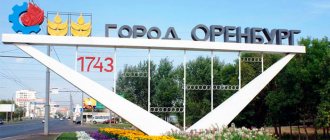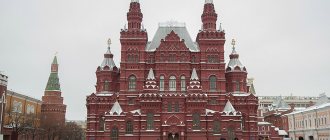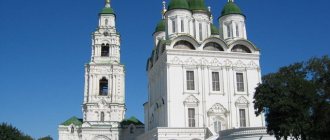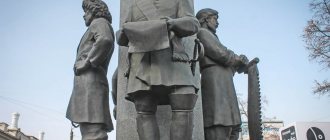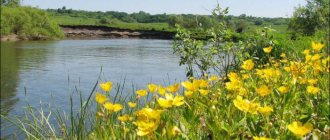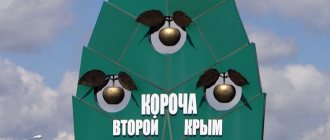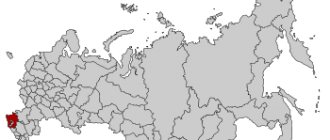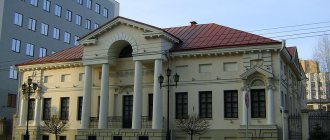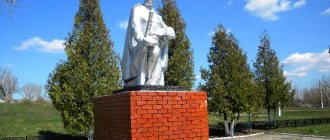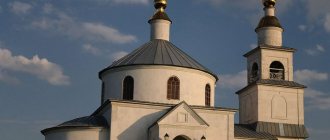The formation of the city of Belgorod, according to historical facts, dates back to the end of the fifteenth century; Tsar Fyodor Ioannovich ordered the construction of the Belgorod fortress to protect against the attacks of the Crimean Tatars.
At the beginning of the sixteenth century, the fortress was rebuilt after the raids of the Polish-Lithuanian hordes on the left bank of the Northern Donets, then part of the city was built on the right bank of the river.
Belgorod
Video: Winter Belgorod from above
Basic moments
Nowadays, Belgorod is a large city with a well-developed infrastructure, which is a scientific, economic, cultural and at the same time spiritual center.
The city attracts tourists with its magnificent architecture, numerous streets (there are 576 of them in the city!), picturesque boulevards and avenues, the total length of which is as much as 460 km. In addition, Belgorod is a major transport hub of the country.
It should be noted that Belgorod is the winner of awards for the livability of the city.
You should come to Belgorod to visit the city’s museums – the Art and Literary Museums, and also visit the Academic Theater. Shchepkin, view the diorama “Battle of Kursk” and visit numerous cathedrals in Belgorod.
Tourists can stay in one of the comfortable hotels in Belgorod and have a meal in the city's upscale restaurants.
Climate
The climate of Belgorod belongs to the temperate continental type. In summer the city is dry and hot, and in winter it is quite cool.
Attractions
Belgorod's attractions include numerous museums, theaters and architectural attractions.
For example, you should see the House of Merchant Selivavnov, which houses the Literary Museum, and the mansion of the merchant Goltsov, dating back to the 19th century. The buildings of the Women's Gymnasium on Narodny Boulevard and the residential building on Slavy Avenue are interesting from an architectural point of view. In addition, do not ignore the Volkova estate.
Other interesting places in Belgorod are religious: this is the Transfiguration Cathedral, which is the main temple of the Belgorod-Starooskol diocese, the ancient Smolensk Cathedral, the Assumption-Nicholas Cathedral and others.
In addition, the attractions of Belgorod include the diorama “Battle of Kursk”, as well as the Museum of Local Lore.
Excursions
Excursions in Belgorod are a unique opportunity to get to know the city and its surroundings better.
Thus, the most popular is the sightseeing tour “Belgorod in the Past and Present”. During the sightseeing tour, tourists can view the “Battle of Kursk” diorama, visit the Literary Museum, the Museum of Folk Culture, the Museum of Communications and see other sights of Belgorod.
The following excursions in Belgorod are also interesting: “Holy Belogorye” - a tour of the religious places of the city, an excursion to the Shchepkin Museum, an excursion to the village of Prokhorovka and a visit to the military history museum, a visit to the village of Kupino and the museum “Peasant Compound” and many other excursions of Belgorod.
Story
The history of Belgorod began as the history of a fortress that defended the southern borders of Rus' from the devastating raids of the Tatars from the Crimea. It is believed that the city was founded in 1593, but the first mentions of it date back to an earlier time.
During the Time of Troubles, the history of Belgorod was connected with the Polish-Lithuanian invasions, which destroyed the city to the ground. In general, it is interesting that during the entire period of its existence the city changed its location not once, but three times!
In the 17th century, the history of Belgorod was again turbulent - in total, over 100 years, the city was raided more than 10 times.
The population consisted of Russian peasants, as well as immigrants from Poland and Lithuania. Thus, the history of Belgorod was closely connected with neighboring states.
Until the 18th century, Belgorod was an important strategic point.
Since the 18th century, Belgorod became a district city of the Kursk province.
In peacetime, crafts actively developed in Belgorod, the city conducted active trade, and developed its economy. In particular, the city is famous for its shoemakers, blacksmiths, sheepskin makers, and tanners.
In 1869, the history of Belgorod made a sharp turn: the Kursk-Kharkov-Azov railway was built here. This influenced the growth of the population of Belgorod; industrial enterprises and educational institutions opened in the city.
By the beginning of the 20th century, Belgorod was already a rich county town.
Accommodation
Hotels in Belgorod are modern and comfortable hotels located both in the city itself and on its outskirts.
Note that a night in a Belgorod hotel will cost a tourist from 800 rubles.
The city has both state hotels and private hotels.
Among the best hotels in Belgorod are “Mir” (from 2 thousand rubles), “Milan” (from 2,800 rubles), “Belogorye” (from 3,500 rubles).
More budget options are the Polar Star hotel (1,700 rubles), Success (1,000 rubles).
Sports and active recreation
Active recreation in Belgorod is very popular and very well developed.
So, in the Virazh sports complex you can go karting. The cost of 10 minutes of pleasure is from 2540 rubles.
Paintball is also popular in Belgorod - there are 5 paintball clubs in the city.
Other active recreation activities in the city include roller skating and skiing, parachute jumping at the aviation sports club, and aeronautics.
Transport
Transport in Belgorod is mainly represented by buses and trolleybuses that run throughout the city. The total length of trolleybus routes is over 120 km.
In addition, the city has 2 bus stations, from where you can easily reach the suburbs by bus.
You can call a taxi in Belgorod from any hotel.
Souvenirs
Souvenirs of Belgorod are traditional souvenirs such as key rings, badges and refrigerator magnets with views of the city. Other interesting souvenirs are products of local craftsmen, ceramic products - cups, bells, as well as woven products. Don’t forget to take photographs - they can also become a memorable souvenir, reminiscent of your trip to Belgorod.
How to get there
There are several ways to get to Belgorod. For example, on an airplane. The city has an international class airport "Belgorod".
You can also get to the city by rail - the Belgorod railway station operates here. Travel time from Moscow to Belgorod by train is just over 9 hours.
You can also get to the city by bus: the travel time from Moscow to Belgorod by bus is 8 hours, the cost of tickets in 2013 is 900 rubles.
Airport
Belgorod is served by the international airport of the same name, located in the Eastern District (formerly Sverdlovsk District), which is approximately 4 km from the city center in a northern direction. Buses run between the airport and different parts of the city.
At the moment, planes of Russian airlines are mainly based here, and most of the flights are to regional destinations within Russia. The most popular of them are Moscow, St. Petersburg, Novy Urengoy, Nyagan, Noyabrsk and Kaliningrad. According to the seasonal schedule, planes fly from Belgorod airport to Simferopol and Antalya (in summer), as well as to Phuket, Thailand (in winter).
Population of the Belgorod region
The demographic density is about 57 people/sq.km. As of 2015, the population is 1.55 million people. Two thirds of the total number are residents of cities, the rest are residents of adjacent villages and hamlets.
It is worth noting the general dynamics of population growth over the past 90 years. In 1926, the population of the region was 896 thousand people. Over the next 30 years, this figure increased by almost 25%. By 1970 the number exceeded 1.3 million. As for migration indicators, they are also growing every year. Today in the Belgorod region, in addition to Russians, live 2.8% Ukrainians, 0.5% Armenians, other nationalities: Turks, Azerbaijanis, Moldovans, Belarusians, Tatars, Bulgarians, etc. It is interesting that in the region there is a significant predominance of the female part of the population over masculine.
Theaters
Theaters can be chosen to suit every taste. Children can be taken to a puppet theater or children's musical theater. The pride of the latter is the high-quality stage design, and each performance is accompanied by “live” music from a real orchestra, which significantly makes any performance bright and expressive.
Children's musical theater, Pervomaiskaya street, building 2A
There is also a fashion theater “Panther” in the city. Its catwalk hosts demonstrations of branded clothing performed by professional models. In addition, dance shows are organized here accompanied by performances by vocal performers. The Philharmonic, which includes: a symphony, jazz and orchestra of Russian folk instruments, can pleasantly surprise you with its musical art; chamber choir, vocal and choreographic ensemble "Belogorye".
Belgorod State Philharmonic, Belgorod Regiment Street, 56A
You can go to the Drama Theater, which is named after a fellow countryman - Mikhail Semenovich Shchepkin. He was a great Russian actor, one of the founders of the national acting school.
Right there on the square, next to the theater, you can walk along the pedestrian zone, the so-called Walk of Labor Glory. It was opened in 2002 and is still replenished every year with new names of Belgorod residents who have achieved success and earned honor and glory in various sectors: agriculture, energy, housing and communal services, law enforcement agencies, healthcare institutions, pensions, science and education and many others.
Victory and Lenin parks are located nearby. The first of them is located on the picturesque banks of the Vezelka River and is a favorite walking place for residents and tourists. It gets especially crowded here in the evenings. The decoration of the park is a light and music fountain, in which there is a sculpture of a lion (the symbol of Belgorod). In summer, there is a boat rental shop near the river. With children you can feed the ducks or visit the children's playground.
Vezelka River, Victory Park. Belgorod.
And the main attributes of the park are numerous sculptures dedicated to the memory of the victory in the Second World War: the Alley of Heroes, the monument to Marshal Zhukov, the monument to the liberators.
Fountain "Invincible", Victory Park. Belgorod.
In this place you can educate younger generations about the great feat of their near ancestors. In the park named after V.I. Lenin has a lot of all sorts of attractions - these are various carousels (from small to large), trains, trampolines, an autodrome and electric cars, a shooting gallery, a Ferris wheel and much more. The park has been modernized according to the latest foreign project, combining both wide scope and functionality.
The cute pedestrian bridge spanning Vezelka is a favorite place for couples. On the wedding day, according to tradition, they hang a lock with them, and after that the newlyweds often walk along the bridge. The design is decorated with round lanterns. From the bridge you can see the university campus with the St. Khorkina educational and sports building and the river embankment.
Lovers' Bridge, University Embankment. Belgorod.
On the banks of the Vezelka River stands the State Institute - the largest institution in the entire Belgorod region, the oldest national research university.
National Research University "Belgorod State University"
Near the university in the summer there is a fountain accompanied by light and music. Nearby there is a beautiful sports complex named after Svetlana Khorkina (a famous gymnast originally from Belgorod), which perfectly adorns the landscape of the city. This modern building is a favorite place for sports, leisure and recreation. Every day the complex can host about 120 training groups, in addition to holding training sessions and sports competitions of various levels.
Educational and sports complex of Svetlana Khorkina, B. Khmelnitsky Avenue, building 3
Historical facts of the city
In the place where Belgorod is located today, the first settlements of the Eastern Slavs appeared in the 8th century, but soon the northerners were forced to leave their lands, unable to withstand the pressure of the Pecheneg nomads. Further events developed as follows:
- 884 - The wars of the Kyiv prince Oleg liberate the lands of present-day Belgorod from the Pechenegs.
- 965 - The territory becomes part of the Pereyaslavl principality.
- 1593-1596 — Estimated years of construction of the Belgorod discharge.
- Second decade of the 17th century. — The fortress was destroyed after the invasion of Polish-Lithuanian troops, but was soon restored. For this purpose, the left bank of the Seversky Donets was chosen.
- 1646 - After the attack of the Zaporozhye Cossacks, the fortress was moved to the opposite bank - closer to the bed of the Vezelka River.
- 1658 - Belgorod becomes the main city of the so-called Belgorod Line.
- 1708-1765 — It is the main city in the Belgorod province, but soon becomes a district town in the Kursk province.
- 1918 - After the Treaty of Brest-Litovsk was concluded, Belgorod first became part of the Ukrainian state declared by Hetman Skoropadsky, and then part of the RSFSR, and from 1919 to 1920 it was one of the strongholds of the white movement.
- 1922 - Becomes part of the newly formed USSR.
- From 1941 to 1943 — Survives two occupations by the German army.
- 1954 - The Belgorod region appears on the map of the country, and Belgorod becomes its administrative center.
Geographical features
Belgorod is located on the Central Russian Upland. The right border of the city is represented by the Seversky Donets River. The name of the settlement comes from its geographical location – White Mountain. We can say that the city was built on its slope along the floodplain of the Vezelka River. A little to the south there are ancient guard mounds. On the map the city is represented by a slightly elongated rectangle, the corners of which are directed towards the cardinal points. Belgorod is located in the black earth zone. A significant part of the outskirts is forest-steppe lands. The relief is a plain with minor erosional hills up to 200 meters. Thanks to this, the city is being built up faster and higher every year. The climate here is moderate. In winter it is cool, in summer it is dry and hot. Due to the flat terrain, strong winds are rare. Relative humidity – 76%.
Automobile highways
The following main highways pass through Belgorod:
- M2 "Crimea". The federal highway from Moscow to the state border with Ukraine passes through Tula, Orel, Kursk and Belgorod. The route is an integral part of the E105 - the European route from Norway (the city of Kirkenes) to Yalta through the territory of Russia and Ukraine.
- P186. A regional highway from Belgorod to the border with Ukraine. Intersects with M2 "Crimea".
- 14K-1. Regional highway to Korocha.
